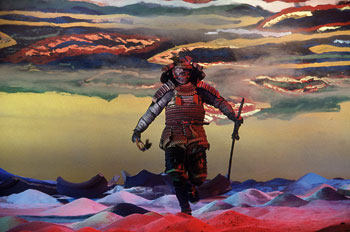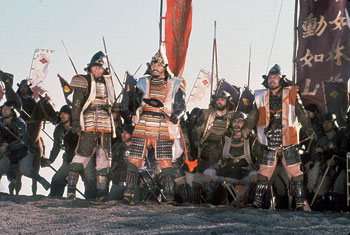Kagemusha: The Shadow Warrior
Akira Kurosawa, Director
The Criterion Collection
$39.95; DVDBy the late 1970s, Akira Kurosawa, the aging lion of Japanese cinema, was having trouble getting financing. Despite his international stature as the auteur of Rashomon, Seven Samurai, and some two dozen other remarkable films, Toho Studios was dragging its feet in backing his ambitious new project. But two of his biggest fans, George Lucas (whose Star Wars films owed so much to the samurai tradition) and Francis Coppola, rode to the rescue with a bag of money from 20th Century Fox, and the result was Kagemusha: The Shadow Warrior. Now it’s on DVD for the first time since its release in 1980, in the uncut, meditatively paced three-hour version that has never before been available outside Japan.It’s a huge film in many ways. Unusual for a Kurosawa film, it retells actual history, the sixteenth-century struggle of Lord Takeda Shingen and several rival warlords to become the country’s supreme ruler. There are epic battles, long lines of troops marching over vast landscapes, alliances and betrayals, and plots and counterplots, much of which can be sorted out only with the aid of Kurosawa scholar Stephen Prince’s excellent audio commentary. The film has about the most sumptuous color cinematography you’ll ever see. There are astonishing moments, as when mad Lord Nobunaga, Shingen’s chief foe, learns of Shingen’s death and immediately breaks into a graceful Noh dance, singing of life’s illusory, impermanent nature; or when soldiers march along a ridge across the face of the setting sun, whose lush rays repeatedly splay and reunite as each man walks past, a painterly elegy for the fast-approaching end of the samurai era. There are also nimble-footed battlefield messengers, comical spies, and, tagging along with each warlord, a slim, silent page whose feminine features hint at what, historically, his actual function was: to be the lord’s sexual partner.
The focal character in the midst of all this pageantry is one who doesn’t belong there at all: a common thief, who has been rescued from crucifixion because of his uncanny resemblance to Lord Shingen. He is trained to act as the lord’s double, or kagemusha, a common practice in those days that could be put to many tactical uses. He learns how to walk, talk, and contemplatively stroke his mustache well enough to make cameo appearances, but when Lord Shingen is felled by a sniper, the thief must take over his role completely. Now the destiny of the clan depends on his not only rallying the lord’s troops but deceiving his grandson, his concubines, and—hardest of all—his horse.

And this is where we, who will probably never vie to plant our flags in Kyoto, connect with the film. As in the story of the two thieves crucified alongside Jesus, it gives us someone we can identify with. For we’re all imperfect, we’ve all done wrong, and, it can even be said, this side of enlightenment we’re all thieves, compulsively snatching what gratification we can from our surroundings, our books and movies, our families and lovers—from anywhere but within ourselves. The thief’s opportunity to ascend to the dignity and power of the lord suggests our own aspiration to rise to something higher. Like him, we usually need some kind of model, whether it’s our teacher or the Buddha or some world-improving secular bodhisattva, be it Einstein, Coltrane, or our nurturing grandma. And, like the thief, we may at first have to emulate some of our role models’ more outward virtues till we can feel our way inward to the essence of what makes them what they are. We fake it till we make it.
The kagemusha’s ultimate test, where he makes it on the inmost level, comes in a frightening night-battle scene, where he must sit—just sit—behind his troops. Lord Shingen, who was nicknamed “Mountain,” was famed for the power of his resolute immovability, and now, with bullets flying all around him, the thief is instructed, “No matter what happens, remain calm and don’t move.” It’s essentially the same test taken (and aced) by Shakyamuni, assailed by the troops of Lord Mara under the Bodhi tree, and it’s the same test that we take every time we sit.
As the thief, Tatsuya Nakadai delineates this transformation with great delicacy. He also plays Lord Shingen, and the subtleties of posture, voice, and facial expression with which he shuttles between the two are remarkable, particularly the contrast between the thief’s sometimes comically loose-limbed carriage and the Noh-paced, mountainlike gravity of the lord. In the Japanese martial arts one learns to become heavy, to let one’s weight sink earthward, and we feel that quality so palpably here in Lord Shingen that it’s hard to believe he’s portrayed by the same actor. Most fascinating and most finely rendered of all is the third thing, which is not quite the thief and not quite the lord, but the thief being the lord. Here Nakadai is topped only by Jeremy Irons as the twin killer gynecologists (you read that right) in David Cronenberg’s creepy Dead Ringers, where Twin A not only impersonates Twin B but occasionally impersonates him mockingly impersonating Twin A. One’s head spins.
But not just for the sake of spinning. There’s a point to all this, and one that is important to dharma practitioners. If a person can be reconstructed from a collage of expressions, gestures, verbal tics, and imputed inner qualities, is it possible that persons are constructed from them in the first place? Am I (or am “I”) just a heap of components? If Elvis goes on rocking people’s worlds through the sneers, vocalizations, and hip-swingings immortalized in his films and records and, yes, in all his impersonators, is it truer to say that Elvis lies in his Memphis grave or that he lives in your iPod, in Vegas, and in 84,000 other locations?

The thief effectively poses this very question when, doffing the black metal war mask that for us evokes Darth Vader, he is for the first time presented to an astounded group of Lord Shingen’s generals. He looks around and asks, “Where is the lord?”—not knowing that Shingen is dead, not yet suspecting that now he himself is all the lord there is. Where, indeed, is the lord, where is that big shot, the self we work so hard to impersonate? And the situation is the same for the bodhisattvas we emulate, except that they know it. Lacking selves, the buddhas we meet in the road don’t have to be killed; they’re dead already. The shadow warrior shadows a warrior who is himself a shadow.
This dizzying pattern is repeated on endless levels. The general who recruits and trains the kagemusha is Shingen’s younger brother and occasionally acts as a kagemusha himself. At crucial moments the major characters cast literal shadows on the walls behind them: in one dramatic instance, thief-as-Shingen walks out of the frame toward the light and the shadow swallows up his place. Offscreen, in the Kyoto stronghold that the lords long to invade, is the emperor, who is himself merely a figurehead, a shadow of what he’s supposed to be, propped up by more rituals and costumes. And even Nakadai, in playing the kagemusha playing Shingen, is shadowing another actor, Shintaro Katsu, the popular comedian for whom Kurosawa wrote the role before falling out with him early in the production, leaving us with Nakadai as Katsu as thief as Shingen.
Shakespeare also created a drama about a fierce warlord who kills and cons his way toward ruling his land. When Macbeth finally crashes in disillusionment, he has an epiphany:
Life’s but a walking shadow, a poor
player
That struts and frets his hour upon
the stage
And then is heard no more.
What Macbeth doesn’t know, but we learn from our practice, is that the shadowlike insubstantiality of existence is fine—in fact, as we settle into it, it turns out to be absolutely liberating. Then we’re no longer caught up in the strutting and fretting (or kvelling and kvetching, as we say in Sanskrit). And then, if we must be players upon the stage, by carrying ourselves impeccably we need not be poor ones. And then we can just relax and . . . play.